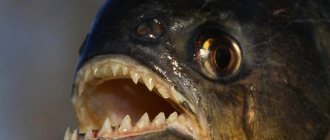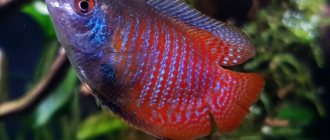A story of horror
There is one story that explains very well why we have this opinion. In 1913, Theodore Roosevelt went on a scientific expedition to Brazil. There he visited one of the local tribes. In order to impress the dear guest, the natives showed him a terrible picture. A dead cow was thrown into a piranha pond. The water boiled in the pond, and among the splashes one could see small fish tearing at the carcass of a cow. Gradually the cow was devoured almost completely. Roosevelt was so impressed that he wrote in his diary that these were extremely dangerous and bloodthirsty creatures.
Fish lifestyle and habitats
Piranhas live both in large and deep rivers and in small streams in Venezuela, Brazil, Peru, Bolivia, Paraguay, Argentina, Colombia, Ecuador and Uruguay. They can also live in small hollows that are flooded with water during the rainy season. The flock usually includes no more than 30 individuals. Prey is almost all living things - snails, amphibians, fish, invertebrates, mammals, sometimes even plants.
Interesting facts about their existence will allow you to learn a lot about piranhas. This type of fish completely controls all living things that fall into the rivers that are their habitat, and local shepherds, in order to cross such a body of water, have to sacrifice one of their animals. While the predators devour him, the rest of the herd manages to cross the river. True, in order to eat, for example, a small ungulate, you need 150-200 fish.
Wild animals have learned to distract fish by deliberately making noise and splashing their paws in shallow water, ensuring that a school of piranhas swims to this place. And when this can be done, the animal quickly runs to where it can safely get a drink or cross the river.
What do piranhas eat?
In fact, according to ichthyologists (the science of fish and other aquatic life), these are rather shy fish. But even here there were some exceptions, but more on that later. Piranhas attack small animals, as well as sick and small fish. It is precisely because piranhas are great at cleaning river spaces from sick fish that they are popularly called “river orderlies.” Almost like wolves, only in rivers. In addition, if these fish are full, they will generally ignore the piece of meat lying on the bottom.
Appearance
Piranha fish is a carp-like fish. The length does not exceed 60 cm. The sides are strongly compressed, the teeth are wedge-shaped. There are more than 50 species, some of them do not reach 15 cm in length.
The most beautiful fish from this family is the red-bellied piranha. It is found in the rivers of the Amazon. Its back is dark steel, its sides are light silver, and its belly and hind fins are bright red. The size is quite suitable for an aquarium - up to 30 cm.
Piranha teeth really deserve a special mention. They are so sharp that they can literally cut a piece off any prey, no matter how hard it is.
The red piranha is considered the most ferocious in its family. This species prefers to live in small flocks of no more than 20 individuals. This allows you to hunt successfully without becoming victims of predators yourself.
I took a bite myself - don’t bother anyone else
Red-bellied piranhas (considered the most dangerous) have a fairly high level of organization compared to many other fish. During the hunt, the school disperses to the sides and if someone finds food, he gives a sign to the others. After this, the flock gathers and begins to eat. After taking a bite, the fish swims to the side so that others can get closer to the food.
By the way, piranhas’ teeth do not wear down like those of dogs or cats. During an attack, they break off or simply fall out. But this does not make the fish less toothy - over the course of their entire life (about 20-25 years), piranhas lose and grow a couple of hundred sharp incisors. The teeth themselves are razor sharp, and when the mouth is closed they work like scissors, “cutting off” portioned pieces of meat or leaves.
Feeding Piranhas at home
In their natural habitat, a school of Piranhas eats everything that gets in its way. They are also omnivores when kept in aquariums.
The following is used as feed:
- sea fish;
- frozen shrimp;
- squid;
- earthworms;
- laboratory and vivarium mice;
- meat trimmings, heart, lungs.
But mammalian meat must be given with caution and in small quantities; it contains too much fat.
It's easy to make friends with these pets by offering them protein treats twice a day. But you should feed them carefully; they can easily bite your finger and hand.
In general, this species is recommended for home keeping only for experienced aquarists, because the tank itself is difficult to care for.
If you have a species aquarium in your house, without neighbors, then once a week you can have a fasting day, since the excessive gluttony of these pets often leads to obesity and decreased immunity.
Piranhas in aquariums
Many people believe that piranhas are so aggressive that they are unsafe to keep at home. In reality this is not the case. Many aquarists keep so-called “tropical” piranha aquariums. Most Popular:
- Slender piranha;
- Paku red;
- Red-bellied;
- Dwarf;
- Flag;
- Metinnis vulgaris;
- Metinnis lunarus.
If you follow the feeding regime, there will be no problems. But if you stick your finger into the aquarium of hungry piranhas, and even twitch it, you can feel all the sharpness of the teeth on yourself.
Reproduction. Spawning
At the 10th month of life, the female is already able to lay eggs.
If piranhas are very large, then they can enter the period of maturity in the second, third, or even fifth year of life.
Piranhas go to spawn in spring and until mid-summer. Female fish lay their eggs on the bottom, mainly closer to the roots of plants, in the silt, digging holes.
There may be, it’s scary to think, 50,000 eggs at a time. The eggs are large and can reach a size of 4 mm.
After a week, the embryos are already feeding on themselves, passing water with microorganisms through themselves. And after two weeks the fry appear.
Parents, protecting their offspring, circle around all the time, driving away and eating enemies.
Interesting! The fry are initially herbivorous, feeding on plankton; as they grow older, they switch to zooplankton and then to small fish.
One piranha requires an aquarium with a volume of at least 100 liters. Accordingly, for four fish - from 300 liters or more. It is imperative to place any objects in the aquarium in which these fish can hide.
№6
They have razor-sharp teeth with a tooth enamel structure very similar to that of sharks. Piranhas have two rows of triangular teeth (upper and lower). Their teeth, like those of sharks, constantly fall out and are replaced with new ones. Also, due to the characteristic structure of the jaws (the lower one is pushed forward), the teeth of their lower row are constantly visible, which gives them a more threatening appearance.
Piranha Diseases
Predators can carry any diseases characteristic of fish, but they have high immunity and survivability, because these orderlies of the underwater world can easily eat sick individuals in the wild.
Injuries from fights often occur, but under good conditions they quickly heal on their own.
Piranhas also have two more scourges - gluttony, which leads to obesity and disease, and timidity. Fear often causes deep stress. In the first case, fasting days and a balanced diet will help. And the owner must learn to protect against the fear of fish. To do this, it is important to study the habits of pets.
Typical diseases can be easily avoided by following all the basic preventive measures in aquarium farming and strictly monitoring the level of nitrogen and ammonia salts.
Some specialize in scales
Fish is a large food source for many piranhas, but the piranha's prey does not always die. Opportunistic piranhas make do with the fin or scales of those that escape, and some species specialize in eating scales, having adapted to feed primarily on the scales of other fish. ()
Scale eating, also known as lepidophagy, has evolved independently in several fish lineages. It is reported to be more common among juvenile piranhas, although some species remain scale-focused as adults, often using specialized hunting techniques. The pennant piranha (Catoprion mento), for example, uses a “high-speed, open-mouth ramming attack,” the researchers wrote in the Journal of Experimental Biology, biting on impact to remove scales with its teeth while dislodging them with the force of its impact. ()
They make sounds to communicate
Common piranha (Pygocentrus nattereri). Henrik Sorensen/Getty Images
Some piranhas make noise when handled; common piranhas, for example, famously “bark” (and sometimes bite) in the hands of anglers who catch them. Little was known about these sounds until recently, when researchers discovered that the species can make three different sounds, each for different situations. ()
The aforementioned "barking" was associated with frontal displays, where the piranhas faced each other for intimidation. Once two piranhas begin actively circling or fighting, the barking may give way to quiet grunting or banging, which researchers suspect is more dangerous. Both sounds are made by the piranha's swim bladder, and the third is produced by the gnashing of teeth during the chase.
How to explain the origin of these animals?
Evolutionary scientists believe that piranhas evolved from a fish ancestor (perhaps the ancestor was common to piranha and pacus) about 8-10 million years ago. The fossil of an extinct megapiranha, which is 1m long, is four times the size of modern representatives of these fish. The megapiranha's teeth were different from those of modern piranha and pacus.
Evolutionary scientists consider megapiranha teeth to be a transitional form between. According to ichthyologist John Lundburg, who studied the fossilized jaw of a megapiranha in 2009, the fish's teeth have an intermediate arrangement, like a zigzag, in which two rows are compressed. The scientist said:
“It looks like the teeth are moving from the second row to the first row.”
In addition, the megapiranha had seven sharp teeth in each quarter of the jaw, rather than six like typical piranhas. Lindbergh added:
“One of the teeth may be missing. Or two of the first seven could have merged together during evolution. This is an unanswered question."
Could the teeth of the meter-long fossil Megapiranha paranensis, arranged in a zigzag pattern, represent the teeth of an ancestor of modern piranhas, which typically have teeth arranged in a single row? Probably yes. Discovered in 2009, the megapiranha was identified as an ancestral form representing the transition to modern piranhas and the veggie pack with its double row of square teeth.
Of course, there is nothing in this fish that would make it an evolutionary transitional form in the sense of the development of bacteria into humans.
Like the modern species and pacu, the megapiranha may well be a descendant of the same ancestor from the original genus of fish, created by God about 6,000 years ago on the 5th day of creation week. Whatever the first fish were, we can be sure from the Word of God that they were not carnivorous in the beginning.
However, when it comes to the number of teeth a piranha has, we don't need long stretches of evolutionary time to explain the variation. Just look at modern views. Even among the four species of the genus Tometes, which are all characterized by tooth shapes—a few chisel-like incisors, wider ones—the normal number varies. Tometes makue has six to eleven teeth, while Tometes lebaili has seven to eight teeth. The vegetarian Tometes camunani has five sharp incisors located in each row, followed by two more not very sharp teeth. (see picture)
The number and shape of piranha teeth varies even within the same species. Such variation within a species—and a genus, and even a taxonomic family—is exactly what we expect from the biblical truth that God created all kinds of creatures to reproduce with diversity within the created genera. Over time, natural selection, mutations, and other mechanisms led to changes that reduced and degenerated the genetic information originally created.
However, the resulting variations, some of which are well adapted to particular environments, do not increase genetic information or produce new, more complex species of creatures. Such variation within created genera is not the same as evolution into different, more complex species of organisms. Whatever the original fish species from which today's piranhas and perhaps pacu evolved, we do not need either the evolution of bacteria into humans or millions of years of "evolutionary time" to explain the existing varieties, since variation within genera can be observed quite quickly in present time.
Piranhas tend to eat whatever is available, and the dental variability seen in Tometes camunani, with an extra two teeth behind the first row, highlights how genetic diversity in a given species of creature can facilitate adaptation to its environment. And geographic isolation of locally well-adapted variations is an excellent way to obtain new species; this is a process that we can observe in real time.
So, since we don't need evolutionary time or molecule-to-person evolution to explain variations in piranha teeth, should we be surprised to find a nominal carnivore in a strictly vegetarian variety? Not at all. No matter what the piranha looked like, we can be sure that it was a herbivore.











